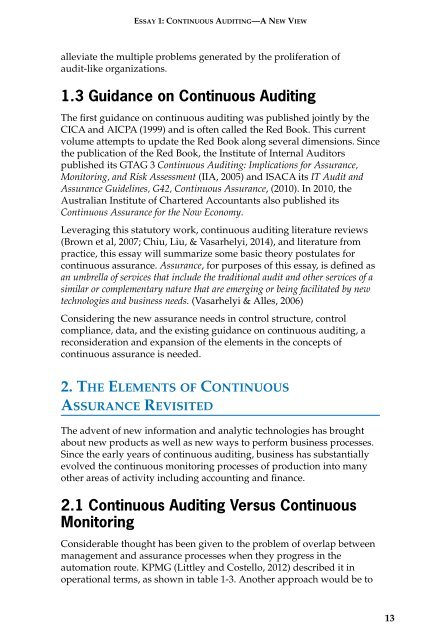AUDIT ANALYTICS AUDIT
1JWn3ix
1JWn3ix
You also want an ePaper? Increase the reach of your titles
YUMPU automatically turns print PDFs into web optimized ePapers that Google loves.
ESSAY 1: CONTINUOUS <strong>AUDIT</strong>ING—A NEW VIEW<br />
alleviate the multiple problems generated by the proliferation of<br />
audit-like organizations.<br />
1.3 Guidance on Continuous Auditing<br />
The first guidance on continuous auditing was published jointly by the<br />
CICA and AICPA (1999) and is often called the Red Book. This current<br />
volume attempts to update the Red Book along several dimensions. Since<br />
the publication of the Red Book, the Institute of Internal Auditors<br />
published its GTAG 3 Continuous Auditing: Implications for Assurance,<br />
Monitoring, and Risk Assessment (IIA, 2005) and ISACA its IT Audit and<br />
Assurance Guidelines, G42, Continuous Assurance, (2010). In 2010, the<br />
Australian Institute of Chartered Accountants also published its<br />
Continuous Assurance for the Now Economy.<br />
Leveraging this statutory work, continuous auditing literature reviews<br />
(Brown et al, 2007; Chiu, Liu, & Vasarhelyi, 2014), and literature from<br />
practice, this essay will summarize some basic theory postulates for<br />
continuous assurance. Assurance, for purposes of this essay, is defined as<br />
an umbrella of services that include the traditional audit and other services of a<br />
similar or complementary nature that are emerging or being facilitated by new<br />
technologies and business needs. (Vasarhelyi & Alles, 2006)<br />
Considering the new assurance needs in control structure, control<br />
compliance, data, and the existing guidance on continuous auditing, a<br />
reconsideration and expansion of the elements in the concepts of<br />
continuous assurance is needed.<br />
2. THE ELEMENTS OF CONTINUOUS<br />
ASSURANCE REVISITED<br />
The advent of new information and analytic technologies has brought<br />
about new products as well as new ways to perform business processes.<br />
Since the early years of continuous auditing, business has substantially<br />
evolved the continuous monitoring processes of production into many<br />
other areas of activity including accounting and finance.<br />
2.1 Continuous Auditing Versus Continuous<br />
Monitoring<br />
Considerable thought has been given to the problem of overlap between<br />
management and assurance processes when they progress in the<br />
automation route. KPMG (Littley and Costello, 2012) described it in<br />
operational terms, as shown in table 1-3. Another approach would be to<br />
13


